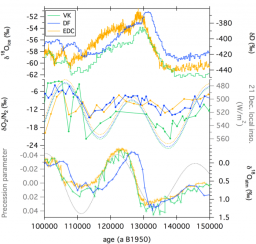Abstract: Orbital tuning is central for ice core chronologies beyond annual layer counting, available back to 60 ka (i.e. thousands of years before 1950) for Greenland ice cores. While several complementary orbital tuning tools have recently been developed using δ18Oatm, δO2⁄N2 and air content with different orbital targets, quantifying their uncertainties remains a challenge. Indeed, the exact processes linking variations of these parameters, measured in the air trapped in ice, to their orbital targets are not yet fully understood. Here, we provide new series of δO2∕N2 and δ18Oatm data encompassing Marine Isotopic Stage (MIS) 5 (between 100 and 160 ka) and the oldest part (340–800 ka) of the East Antarctic EPICA Dome C (EDC) ice core. For the first time, the measurements over MIS 5 allow an inter-comparison of δO2∕N2 and δ18Oatm records from three East Antarctic ice core sites (EDC, Vostok and Dome F). This comparison highlights some site-specific δO2∕N2 variations. Such an observation, the evidence of a 100 ka periodicity in the δO2∕N2 signal and the difficulty to identify extrema and mid-slopes in δO2∕N2 increase the uncertainty associated with the use of δO2∕N2 as an orbital tuning tool, now calculated to be 3–4 ka. When combining records of δ18Oatm and δO2∕N2 from Vostok and EDC, we find a loss of orbital signature for these two parameters during periods of minimum eccentricity (∼ 400 ka, ∼ 720–800 ka). Our data set reveals a time-varying offset between δO2∕N2 and δ18Oatm records over the last 800 ka that we interpret as variations in the lagged response of δ18Oatm to precession. The largest offsets are identified during Terminations II, MIS 8
and MIS 16, corresponding to periods of destabilization of the Northern polar ice sheets. We therefore suggest that the occurrence of Heinrich–like events influences the response of δ18Oatm to precession.
Reference : Climate of the Past, Vol. 12, pages 729-748, 2016

Fig. 1. : Inter-comparison of Vostok (green), Dome F (blue) and EDC (yellow) data covering MIS 5. Vostok and EDC data are presented on AICC2012 (Bazin et al., 2013, Veres et al., 2013) and Dome F on the DFO-2006 chronology (Kawamura et al., 2007). Top: water isotopic composition (Vostok δ18Oice: Petit et al., 1999, Dome F δ18Oice: Kawamura et al., 2007, EDC δD : Jouzel et al., 2007). Middle: δO2/N2 records and local summer solstice insolation at each site (Suwa and Bender 2008, Kawamura et al., 2007, this study). Bottom: δ18Oatm and precession parameter shifted by 5 ka (Suwa and Bender 2008, Kawamura et al., 2007, Landais et al., 2013, this study).






